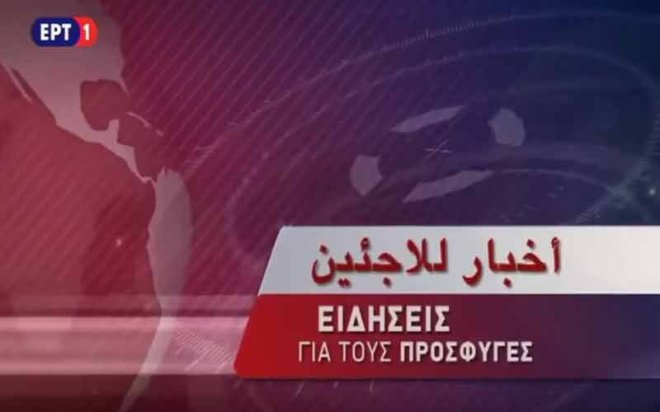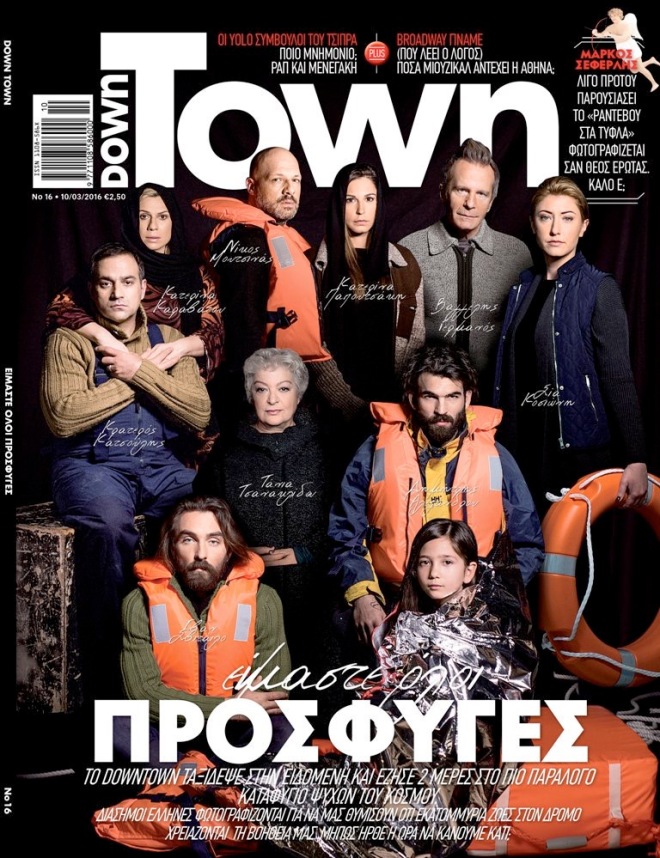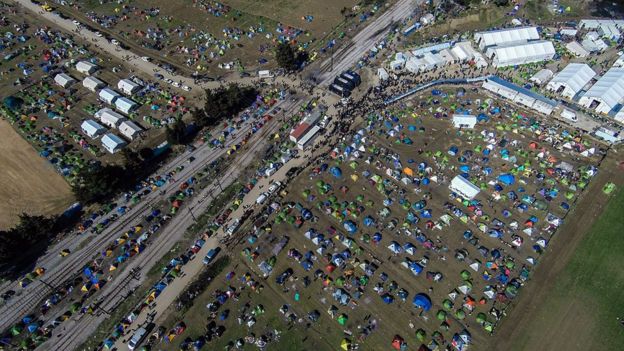
One particularly memorable episode of Monty Python’s Flying Circus features a series of sketches, starting with “News for Parrots” (“… and now the news for parrots. No parrots were involved in an accident on the M1 today…”) and culminating in the utterly absurd “News for Wombats”. This is what I was reminded of when the Greek public broadcaster ERT launched its “news bulletin for refugees” last week, aimed at the 50,000-odd refugees and migrants stranded in Greece. Other observers took the news far more seriously.
ERT claims to have received several hundred complaints from viewers following the broadcast. Right-wing (and more extreme) commentators were quick to comment on social media using terms like “shame”, “debasement”, “national capitulation” and “muslim colonisation”, and questioning why public funds were spent on it. The outrage reached its peak when a screenshot featuring a female newsreader in a hijab made the rounds of the social media as well as some mainstream news sources. It was eventually exposed as a hoax, in which someone had photoshopped a screenshot of a Saudi news presenter from a BBC report onto the ERT backdrop, but the debunking did not gain nearly as much prominence as the initial outrage. The fake headscarf controversy dovetailed neatly with a real headscarf controversy when an Egyptian student marched with her school in the Greek independence day parade on the 25th March in a hijab. Then some viewers selectively picked out the word “Macedonia” in the spoken Arabic ERT and assumed (wrongly) that the newsreader had used the M-word without its mandated qualifiers – taken to be a sign of a further national debasement. And it all went downhill from there…
What was most noticeable in the public “debate” which ensued is how much ground needs to be covered in very short order, for Greeks to be able to cope culturally with the dawning reality that many of the new arrivals will be around for quite some time.
All of which fuss, however, is not real reason to criticise ERT for its “News for Refugees” initiative – unless you have an agenda. Here I will take at face value the public broadcaster’s initiative to reach beyond its native audience, and instead outline how I think it is failing the refugees and migrants in terms of language, message and medium – in fact, in just about every possible way – and what might be the subtext.
The language
At a very basic level, there is a limitation in terms of the language chosen, namely Arabic. Although the most of the migrants and refugees (according to UNHCR figures) come from majority Arabic speaking countries (Syria and Iraq), they also include a substantial minority of Dari and Farsi speakers from Afghanistan and Iran, as well as Kurdish speakers from across the region and to a lesser extent Urdu (among Pakistanis). Local radio stations, including Athens municipal radio have already been broadcasting in several languages (including Arabic) aimed at visitor and immigrant communities for some years. But leaving that limitation aside, there are more fundamental flaws in the way the ERT project has been conceived and implemented.
The message
I use quotation marks around “news” because the content of the bulletin isn’t exactly news. It sounds (or reads, in my case, as I rely on the Greek subtitles) more like a public service announcement in a dystopian communist regime that has just been struck by a disaster – something like Chernobyl perhaps. It starts by reminding migrants that the borders are closed, and directing them to disband in an orderly manner from makeshift camps like Idomeni and Piraeus and avail themselves of the free bus service to organised accommodation; it asks people to not believe information from non-official sources; it gives information on where to register for relocation and assistance programmes; it lists the regulated prices for bottled water and sandwiches; and it closes with a weather forecast.
The urge to convey this information is understandable – for months, the Greek government has been criticised for allowing disinformation and price gouging to run riot around the migrant camps. However, to the extent that the bulletin reaches its intended audience (more of which below), we might question whether the tone and format will engender trust in people who are in many cases fleeing authoritarian regimes, and who are presumably fed up to the back teeth of being directed by anything with the whiff of official propaganda.
And then there is that title – “News for Refugees” – that lingers on screen, as if to remind the viewer that this is intended for a different class of person, one as distant from normal everyday reality as a parrot or a wombat perhaps…
When ERT addresses the Greek viewing public on the subject of the refugee crisis, its coverage is just as cloying, condescending and sensationalist as any of the private channels. Recently, a man featured on an ERT news report about volunteering as a temporary host for refugee families complained that the report had systematically misrepresented his situation and that of his guests. He detailed how the crew arrived without a translator to interview his guests, and subsequently edited the interviews to remove any reference to the complexity of the refugee crisis and the situation in Syria, the exploitation his guests suffered by Greek taxi drivers, and any personal details that might have served to humanise them in the eyes of the viewer. He accused ERT of trying to fit everything into the “easily digestible schema of beleaguered refugee vs. charitable Greek”.
The medium
Under normal circumstances, one would expect a rudimentary element of audience research before launching a new service, especially one as challenging as this. Even in these circumstances, you don’t need to be a market research genie to quickly conclude that very few (if any) of your intended audience are dedicated TV viewers – for a variety of practical reasons, mainly to do with living on the run. Beyond that, some information can be gleaned for free from the surveys that the UNHCR has been conducting on recent arrivals in Greece. For example, among Syrians arriving in February, 24% said that they had sourced information on their journey from social media, mobile apps or specialised websites. Only 8% of Afghans arriving over the same period cited these sources. The top source for Syrians were travel companions (43%), friends and family at destination (25%), calling someone ahead on the route (23%) and people smugglers (16%). Afghans had relied overwhelmingly on people smugglers (73%) for information. In neither group does television feature as an information source – presumably because they have not spent their journey in four- and five-star accommodation with satellite TV.
Internet media, rather than conventional phone networks, are what many migrants and refugees use to communicate as they travel – so even as they get their information from a person (traffickers, friends and family) they get it via apps and social media. The smartphones (which have been the focus of resentment by sceptical European observers) act as telephone, mail, bulletin board, navigation aid and location beacon, as they pass through countries where their native language is not spoken. The people traffickers have in fact been using social media to drum up business for some time. A risk report issued by the European border agency Frontex in 2014 cited examples of Facebook pages touting for business in Turkey and flagged social media as an area of concern for combatting human trafficking. Several media reports have also highlighted the social media strategy of the smugglers, also using platforms like Twitter, WhatsApp and Viber. Local support groups also use Facebook more legitimately to gather and disseminate information in a variety of languages.
This is an on-the-go version of technological “leapfrogging”, where the bush telegraph and the mobile app shake hands, bypassing the old media of newspapers and television. Last week, three people died and several hundred were apprehended by the Macedonian authorities and returned to Greece after following directions circulated in a photocopied leaflet – a very low-tech medium indeed. On Sunday, a few hundred refugees and migrants were attracted back to Idomeni by rumours that the border was about to reopen, apparently spread on Facebook. So, to cut a long story short, a tiny bit of common sense would have told that people living in tents don’t watch TV (unless they are European families on a “camping” holiday with their satellite dish), and a little bit of research would have pointed to existing successful models for “penetrating that hard-to-reach audience”.
The subtext
But then, our public broadcaster seems to have only a passing relationship with, or interest in, their native audience. Very few Greeks get their news from ERT. The Syriza/ANEL government restored the public broadcaster to its original identity (and staffing levels) last year, reversing its forcible closure and restructuring under the Samaras government. However, despite the heavy political significance invested in it, most Greeks who also pay compulsory fee to fund it through their electricity bills, do not watch it. ERT’s evening news bulletin is stuck at the bottom of the ratings – the latest figures show it reaching an audience of 153,000 – or 3.6% share. The channel directors are so unhappy with this state of affairs that they have announced their intention to challenge the ratings, in a move reminiscent of the government’s initiative to regulate polling organisations. In this context it is hard to trust ERT’s own claim that the Arabic news bulletin has had a “great response among Arabic-speaking migrants staying in our country.” It is also hard to assess how many of the “approximately 30,000 viewers” who watched the first bulletin online were the intended audience rather than curious Greeks clicking to be outraged by the scarfed woman saying the M-word.
These are blindingly obvious weaknesses that suggest that the originators of the idea, however well-intentioned they may have been, operate in some kind of state-sponsored media bubble. In the best case they merely missed their target by a wide mile. More likely they had other targets in mind – like flattering a domestic audience with the illusion that the government is doing its humanitarian best to manage a chaotic situation, but that ultimately all we can do is be charitable and not bother ourselves with the messy complexities. Such a smug and self-serving approach, however, will ultimately backfire. The initial reactions suggest that we ignore the nuances at our peril.





